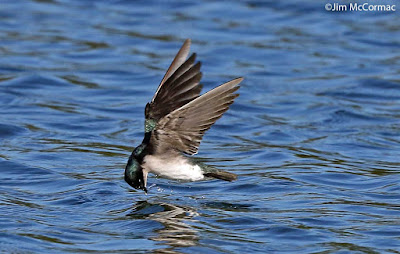On October 11, I made an expedition to the St. Marys Fish Hatchery in western Auglaize County, near the eastern shore of Grand Lake St. Marys. The primary purpose was to photograph shorebirds, especially White-rumped Sandpipers. I had success on that score, returning with many nice files of white-rumps and several other species. You can see some of those photos HERE, and HERE.
But life is not just shorebirds, and after I was done shooting those, I set out to walk the entire hatchery and see what the other ponds and wetlands might hold.
One of the drawn-down ponds held the carcasses of a number of sizeable fish, and these tasty sun-baked morsels had not escaped the Turkey Vultures' sharp eyes. Or nostrils. Vultures don't miss a trick. They rank high among the most observant, and intelligent, birds in the world.
Turkey Vultures are conspicuous on the wing, with their six and a half foot wingspans. Despite the birds' massive size, they can be harder to make crisp images of than one might think. That's because the bird is often FAR away, much further than one might think. Huge crops in post-processing often produce a rather noisy image that lacks in crispness. But this situation allowed close access. I stood on the edge of a fencerow and shot the birds as they came and went.
These images were made with a tripod-mounted Canon 7D Mark II, with the 500mm f/4 II lens. A 1.4x teleconverter connected the two, making for 700mm of reach and that's not counting the 1.6x crop factor of the camera. Such a rig allows for LONG reach, and the photographer can stay out of the birds' wariness zone. This photo was shot at f/8, 1/3200, and ISO 500.
A juvenile Turkey Vulture wafts by. Notice its dusky-gray head. Shooting vultures, at least when they're as close as these ones were, is relative child's play. They don't move fast enough to present major challenges. It's more a matter of keeping the camera trained on the subject, and waiting until the bird presents a good angle, with the best available light. All settings were the same for this shot as the prior two.
Flying Tree Swallows present a far greater photographic challenge. One of the ponds had 100 or so of the little speedsters zipping about, and I spent a bit of time trying for shots. While some are OK, none are fabulous. My biggest mistake here was not having my 100-400mm lens along. That lens is great for handheld flying bird images, as can be judged by the examples RIGHT HERE.
So, to experiment, I took the 1.4x teleconverter off, and tried shooting the birds with the straight 500mm off the tripod. I probably should have tried for some handheld shots as well, but the big lens acts a bit like a kite in windy conditions, and that makes it hard to get sharp shots. This image came out OK. It was shot at f/7.1, 1/2000, ISO 500, and -1/3rd stop exposure compensation.
Locking on and keeping focus on flying swallows on a breezy day is tough. Most of my efforts went into the digital dust bin. But it wouldn't have mattered much if I got any keepers or not. Tree Swallows are one of my favorite birds, and it was fund to watch their antics and aerobatics. This one is in the act of water-skimming - hitting the water with the top of its head, and with a quick backwards neck snap, sending a spray of water over its body. When you fly as well as these birds do, almost everything can be done on the wing: feeding, bathing, drinking, even mating.
I look forward to honing my skills some more with swallows in flight, but that's probably going to have to wait until next spring (unless a Florida trip pops up this winter!).







No comments:
Post a Comment